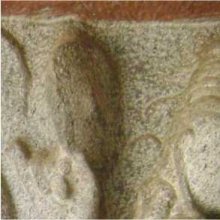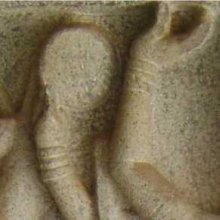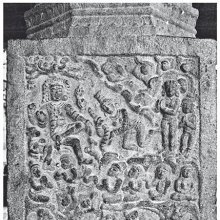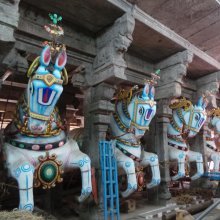Mandapa, Māṇḍapa, Maṇḍapa, Mamdapa: 34 definitions
Introduction:
Mandapa means something in Hinduism, Sanskrit, Buddhism, Pali, the history of ancient India, Marathi, biology. If you want to know the exact meaning, history, etymology or English translation of this term then check out the descriptions on this page. Add your comment or reference to a book if you want to contribute to this summary article.
Images (photo gallery)
(+95 more images available)
In Hinduism
Vastushastra (architecture)
Source: Wisdom Library: Vāstu-śāstraMaṇḍapa (मण्डप) is a Sanskrit technical term translating to “pavilion” or “porch”, which as a detached temple building serves various educational and recreational purposes. It can also be translated as a “pillared hall”. It is used throughout Vāstuśāstra literature. The 11th-century Samarāṅgaṇasūtradhāra (chapter 66-67) by Bhojadeva describes thirty-five types of Maṇḍapas divided in two groups.
Source: Digital Library of India: Bharatiya Vastu-sastra volume 1A Maṇḍapa (मण्डप) in conncetion with the Hindu Temple is a detached temple, a pavilion, an open hall. But they are not exhaustive. We know that in India some of the temples and monasteries of old grew into universities. The more famous among them had invariable attached to them these detached buildings to server as rest-houses, congregational places and places for sermons, discourses and religious discussions and other allied necessities both of the pilgrims and those permanently stationed there; the hermits, the Yatis and the Vanīs (forest dwellers) along with their disciples and pupils.
Maṇḍapas, besides serving this sacred purpose had, as detached buildings of Hindu Temple, been serving secular purpose als from times immemoral. Dance, drama, music, gambling and so many other sources of recreation and enjoyment took place in these Maṇḍapas.
Maṇḍapa is either square or rectangular. The super-structure of the Maṇḍapa must not exceed in height, the Śukanāsā of the Prāsāda. The Śukanāsā however, itself varies at different periods and in the various types of temples from having half the height of the Śikhara to a less ‘perfect’ proportion. While thus the height of the Maṇḍapa depends upon the height of the temple and its Śukanāsā, its proportion is not a fixed one in plan, however, the centre of the Maṇḍapa is in a fixed proportion to the Garbhagṛha; its central square has the same area.
Source: Knowledge Traditions & Practices of India: Architecture (1): Early and Classical ArchitectureMaṇḍapa (मण्डप, “hall”) refers to a common concept found in the ancient Indian “science of architecture” (vāstuvidyā).—Maṇḍapa is an open pillared hall for public events, including rituals, discourses or art performances.
Source: OpenEdition books: Architectural terms contained in Ajitāgama and RauravāgamaMaṇḍapa (मण्डप) refers to “pavilion (building whose elevation comprises only three levels) passim see in particular §§ 4.13 et seq. as well as 4.9; 5.9, 14.”.—(For paragraphs cf. Les enseignements architecturaux de l'Ajitāgama et du Rauravāgama by Bruno Dagens)
Source: Shodhganga: Elements of Art and Architecture in the Trtiyakhanda of the Visnudharmottarapurana (vastu)1) Maṇḍapa (मण्डप) refers to the “pavilion” part of the Hindu Temple, according to the Viṣṇudharmottarapurāṇa, an ancient Sanskrit text which (being encyclopedic in nature) deals with a variety of cultural topics such as arts, architecture, music, grammar and astronomy.—Maṇḍapa means the pavilion of a temple. The height of the maṇḍapa is fixed with nine tāla according to the Mayamata. In the Suprabhedāgama, four kinds of maṇḍapas are mentioned and devatāmaṇḍapa is regarded as the first one. According to the Garuḍapurāṇa, the measurement of a maṇḍapa should be ten or twelve cubits and the maṇḍapa should be supported by sixteen pillars. Though the Viṣṇudharmottarapurāṇa does not talk about the structure, measurement etc. of a maṇḍapa, this book carries the discussion about different temples having maṇḍapas which will be discussed later.
2) Maṇḍapa (मण्डप) refers to one of the hundred types of Temples (in ancient Indian architecture).—It is quite difficult to say about a definite number of varieties of Hindu temples but in the Viṣṇudharmottarapurāṇa hundred varieties of temples have been enumerated. For example, Maṇḍapa. These temples are classified according to the particular shape, amount of storeys and other common elements, such as the number of pavilions, doors and roofs.

Vastushastra (वास्तुशास्त्र, vāstuśāstra) refers to the ancient Indian science (shastra) of architecture (vastu), dealing with topics such architecture, sculpture, town-building, fort building and various other constructions. Vastu also deals with the philosophy of the architectural relation with the cosmic universe.
Vaishnavism (Vaishava dharma)
Source: ISKCON Press: GlossaryMaṇḍapa (मण्डप).—Halls of the temple, often with many pillars. They are one or more entrance porches or halls that lead to the vimana or inner sanctum.

Vaishnava (वैष्णव, vaiṣṇava) or vaishnavism (vaiṣṇavism) represents a tradition of Hinduism worshipping Vishnu as the supreme Lord. Similar to the Shaktism and Shaivism traditions, Vaishnavism also developed as an individual movement, famous for its exposition of the dashavatara (‘ten avatars of Vishnu’).
Purana and Itihasa (epic history)
Source: Wisdom Library: PurāṇasMaṇḍapa (सुभद्र) refers to a “halls attached to the temple”, according to the Matsya-purāṇa (verses 270.1-30). The Matsyapurāṇa is one of the eighteen major purāṇas dating from the 1st-millennium BCE.
There are 27 varieties of maṇḍapa mentioned:
- Puṣpaka (64 pillars),
- Puṣpabhadra (62 pillars),
- Suvrata (60 pillars),
- Amṛtamanthana (58 pillars),
- Kauśalya (56 pillars),
- Buddhisaṅkīrṇa (54 pillars),
- Gajabhadra (52 pillars),
- Jayāvaha (50 pillars),
- Śrīvatsa (48 pillars),
- Vijaya (46 pillars),
- Vāstukīrti (44 pillars),
- Śrutiṃjaya (42 pillars),
- Yajñabhadra (40 pillars),
- Viśālaka (38 pillars),
- Suśliṣṭa (36 pillars),
- Śatrumardana (34 pillars),
- Bhāgapañca (32 pillars),
- Nandana (30 pillars),
- Mānava (28 pillars),
- Mānabhadra (26 pillars),
- Sugrīva (24 pillars),
- Harita (22 pillars),
- Karṇikāra (20 pillars),
- Śatardhika (18 pillars),
- Siṃha (16 pillars),
- Śyāmabhadra (14 pillars),
- Subhadra (12 pillars).
Accordingly (verse 270.15-17), “These maṇḍapas (e.g., subhadra) should be either made triangular, circular, octagonal or with 16 sides or they are square. They promote kingdoms, victory, longevity, sons, wife and nourishment respecitvely. Temples of other shape than these are inauspicious.”
Source: archive.org: Shiva Purana - English TranslationMaṇḍapa (मण्डप) refers to a “dais (raised platform)” (suitable for a marriage ceremony), according to the Śivapurāṇa 2.3.38 (“Description of the dais or maṇḍapa”).—Accordingly, as Himavat prepared the wedding of Menā and Śiva: “[...] He called Viśvakarman and requested him to erect a large and spacious dais (maṇḍapa) beautiful with side rostrums, altars etc. The dais, O celestial sage, was ten thousand Yojanas wide. It was wonderfully constructed and had all the characteristic features. All the mobile and immobile objects of the world were represented there with realistic appearance. Everything was wonderfully portrayed. The mobile objects presented there surpassed the immobile ones and the immobile ones surpassed the mobile ones in excellence. [...]”.
Source: Cologne Digital Sanskrit Dictionaries: The Purana IndexMaṇḍapa (मण्डप).—Three kinds of, superior, middling and inferior; the different varieties are Puṣpaka, Puṣpabhadra, Suvrata, Amṛtananda, Kauśalya, Buddhisamkīrṇa, Gajabhadrā, Jayāvaha, Śrīvatsa, Vijaya, Vāstukīrti, Śrutinjaya, Yajñabhadra, Viśāla, Suśliṣṭa, Śatrumardana, Bhāgapañca, Nandana, Mānava, Mānabhadraka, Sugrīva. Harita, Karnikāra, Śatardhika, Simha, Śyāmabhadra, Subhadra, all totalling 27; these may be triangular, circular, semi-circular, eight cornered, sixteen cornered, etc.; generally ten kinds of doorways are furnished avoiding vedha; fruit and flower trees are to be grown all round; a pool of water must be maintained; on the south a tapovanam, on the north a devī temple, on the north-east a kitchen and on the south-east a Vināyaka shrine and then Yajñaśālā; these constitute a temple; the bell near the gateway.*
- * Matsya-purāṇa 270. 1-36.

The Purana (पुराण, purāṇas) refers to Sanskrit literature preserving ancient India’s vast cultural history, including historical legends, religious ceremonies, various arts and sciences. The eighteen mahapuranas total over 400,000 shlokas (metrical couplets) and date to at least several centuries BCE.
Shaktism (Shakta philosophy)
Source: Wisdom Library: ŚāktismMaṇḍapa (मण्डप) the Erection of maṇḍapa is the name of preliminary rite of Śaktism mentioned, for example, in the Śāradātilaka-tantra III-V.— A beautiful square maṇḍapa is built on smooth ground on an auspicious day with the recitation of mantras. It should measure five, seven or nine hastas on each Bide. It consists of sixteen pillars, of which four pillars, each eight hastas in length, should be in the middle and the remaining twelve, each five hastas in length, stand round the maṇḍapa. One fifth of each pillar is buried in the ground. The maṇḍapa is decorated on all sides with coconut leaves and bamboos. The doors are arched. The height of the gate pillars is ordained seven hastas and the circumference ten aṅgulas. Flags are hoisted on all sides and the maṇḍapa is decorated with canopies, garlands, Kuśa grass and such other things. A quadrangular altar is prepared in the middle. It occupies one-third of the total area of the maṇḍapa.
Source: Google Books: ManthanabhairavatantramMaṇḍapa (मण्डप) refers to a “(level) canopy”, according to the Ṣaṭsāhasrasaṃhitā, an expansion of the Kubjikāmatatantra: the earliest popular and most authoritative Tantra of the Kubjikā cult.—Accordingly, “One should institute a great sacrifice at times of great fear, [...]. This (great sacrifice) brings every success and is the sure means of getting (whatever) one thinks about. I will tell (you) that clearly as it (truly) is. One should make a level canopy [i.e., maṇḍapa] measuring sixteen (handspans) in a frightening forest, or (beside) a solitary tree or a single beautiful Liṅga, in a temple dedicated to the Mothers, on a battle ground, on a threshing floor, in a house, or (places) that are tranquil, terrifying, or romantic as one pleases. Beautiful with flags and garlands, (it is erected) [i.e., the canopy—maṇḍapa] to (win) victory in battle with the enemy and for other purposes as they arise, each separately”.

Shakta (शाक्त, śākta) or Shaktism (śāktism) represents a tradition of Hinduism where the Goddess (Devi) is revered and worshipped. Shakta literature includes a range of scriptures, including various Agamas and Tantras, although its roots may be traced back to the Vedas.
Ayurveda (science of life)
Source: Knowledge Traditions & Practices of India: Agriculture: A SurveyMaṇḍapa (मण्डप, “canopy”) refers to one of the layout designs for gardens and orchards mentioned in the Vṛkṣāyurveda: a Sanskrit text by written by Surapāla that deals with agriculture (kṛṣi).—Surapāla’s text mentions 170 species of plants including trees, shrubs and a few herbs, and deals with the laying out gardens and orchards and growing unusual trees. Layouts included designs such as maṇḍapa (canopy).

Āyurveda (आयुर्वेद, ayurveda) is a branch of Indian science dealing with medicine, herbalism, taxology, anatomy, surgery, alchemy and related topics. Traditional practice of Āyurveda in ancient India dates back to at least the first millenium BC. Literature is commonly written in Sanskrit using various poetic metres.
Shilpashastra (iconography)
Source: Shodhganga: The significance of the mūla-beras (śilpa)Maṇḍapa (मण्डप) refers to the “various columned halls” of the Hindu temple.—The Hindu temple displays sculptures on the outer surface, the maṇḍapas (the various columned halls) and the prāsāda (a three-storeyed palace, a complete solid mass, on whose multi-buttressed walls the images are displayed), in which the innermost sanctuary or the garbhagṛha is located. The garbhagṛha or the womb cell is a small, dark, cubical chamber even in the largest temples. The divine symbol or the deity, invariably carved out of stone, is installed in the garbhagṛha. The door of this cell usually faces the east.
In front of the doorway is the rectangular chamber which is called the antarāla or vestibule. The vestibule is the intermediate chamber between the garbhagṛha and the pillared hall called the maṇḍapa. Entrance to the maṇḍapa is by a porch called the ardha-maṇḍapa (the hall leading to the inner sanctum sanctorum). In a fully formed temple there may be a transept on each side of the central hall known as the mahāmaṇḍapa. All the principal parts of this structure are crowned by pyramidal towers. The tallest is the tower on the sanctum and the shortest is the one on the porch. All round the sanctum is a passage meant for circumambulation by the devotees. The mukha-maṇḍapa is the front hall in front of the shrine.

Shilpashastra (शिल्पशास्त्र, śilpaśāstra) represents the ancient Indian science (shastra) of creative arts (shilpa) such as sculpture, iconography and painting. Closely related to Vastushastra (architecture), they often share the same literature.
Pancaratra (worship of Nārāyaṇa)
Source: University of Vienna: Sudarśana's Worship at the Royal Court According to the AhirbudhnyasaṃhitāMaṇḍapa (मण्डप) refers to a “pavilion”, according to the Ahirbudhnyasaṃhitā, belonging to the Pāñcarātra tradition which deals with theology, rituals, iconography, narrative mythology and others.—Accordingly, “An abnormal modification caused by a aggressive ritual against Kings, occurring at the improper time, dreadful and all-reaching, is characterized by the these signs: [...] the earth produces less grains and multitudes of cows fall dead; his kingdom suffers again and again from droughts; the Earth-Master’s Queens are seized by serious illness; snakes and ants appear in the palace, at the main gate and in the pavilion (maṇḍapa); [...] from such and other signs he should understand that the enemy is performing a aggressive ritual”.

Pancaratra (पाञ्चरात्र, pāñcarātra) represents a tradition of Hinduism where Narayana is revered and worshipped. Closeley related to Vaishnavism, the Pancaratra literature includes various Agamas and tantras incorporating many Vaishnava philosophies.
Natyashastra (theatrics and dramaturgy)
Source: Shodhganga: Elements of Art and Architecture in the Trtiyakhanda of the Visnudharmottarapurana (natya)Maṇḍapa (मण्डप) refers to the “pavilion” which should be oblong or square, according to the Viṣṇudharmottarapurāṇa, an ancient Sanskrit text which (being encyclopedic in nature) deals with a variety of cultural topics such as arts, architecture, music, grammar and astronomy.—Drama should be performed under a maṇḍapa i.e., pavilion. According to the Viṣṇudharmottarapurāṇa, the pavilion should be oblong or square. The square one should be thirty two hands and the oblong one should be double of it in size. In the beginning of the Drama the devatāpūjana should be done. A nāndīśloka i.e., a benedictory verse must be recited at the very beginning of a Drama for a successful ending.

Natyashastra (नाट्यशास्त्र, nāṭyaśāstra) refers to both the ancient Indian tradition (shastra) of performing arts, (natya—theatrics, drama, dance, music), as well as the name of a Sanskrit work dealing with these subjects. It also teaches the rules for composing Dramatic plays (nataka), construction and performance of Theater, and Poetic works (kavya).
India history and geography
Source: Shodhganga: Ajanta’s antiquityMaṇḍapa (मण्डप, “pavilion”) is a word commonly used in the Ajantā caves: an archaeologically important site in terms of ancient Buddhism.—The word ‘maṇḍapa’—literally, a ‘pavilion’—as mentioned in the inscriptions of caves 16, 20, etc. meant a pavilion, secular or sacred. Since the Buddha frequently sat in a maṇḍapa—as depicted in Buddhist literature, seen in Ajantā paintings, and evident in the architectural basis of the Ajantā caves that follows the idea of the maṇḍapa—the word gradually appears to have acquired the connotation of a Buddha temple. Perhaps, this is the reason why the caves with a shrine have been called maṇḍapas in inscriptions.
Source: Cologne Digital Sanskrit Dictionaries: Indian Epigraphical GlossaryMaṇḍapa.—(IE 8-3), customs house; Marāṭhī māṇḍavī, from Sanskrit maṇḍapikā; explained by some as ‘a market place’ (Hindī maṇḍī); but Hindī maṇḍī seems to be derived from the same word because the toll-stations were often situated in market- places. (BL), name of a structure in front of a temple. (LL), a porch or hall. (CII 4), the hall in a temple. (CII 4), a temple. (EI 31), a temple or public building. Cf. vaiccamudu-maṇḍapa (SITI), kitchen; same as maḍaip- paḻḻi. Cf. vakkāṇikku-maṇḍapa (SITI), hall where disputations in the śāstras are held. Cf. śanivāra-maṇḍapa. Note: maṇḍapa is defined in the “Indian epigraphical glossary” as it can be found on ancient inscriptions commonly written in Sanskrit, Prakrit or Dravidian languages.
Source: Heidelberg: Glory of the Tiruvanantapuram Padmanabhasvami TempleMaṇḍapa (मण्डप) refers to the “pillared halls” of Hindu temples, according to the Syānandūrapuravarṇana-prabandha by Svāti-Tirunāḷ (1813-1846) (one of the rulers of Travancore) which deals with the different activities of the Thiruvananthapuram Temple, including ceremonies and festivals.—[...] The fifth chapter also gives a detailed sketch of the temple and its components, such as the balipīṭha (pedestal for food offerings) (5.8), various maṇḍapas (pillared halls) (5.9–10), vimānas (towers on top of the sanctum) (5.10), the single stone maṇḍapa (5.11), the dhvajastambha (flag-post) (5.12–14), the gopura (towers at the entrances) (5.14–15), the kulaśekharamaṇḍapa (5.15), etc.

The history of India traces the identification of countries, villages, towns and other regions of India, as well as mythology, zoology, royal dynasties, rulers, tribes, local festivities and traditions and regional languages. Ancient India enjoyed religious freedom and encourages the path of Dharma, a concept common to Buddhism, Hinduism, and Jainism.
Biology (plants and animals)
Source: Google Books: CRC World Dictionary (Regional names)Mandapa in India is the name of a plant defined with Hiptage benghalensis in various botanical sources. This page contains potential references in Ayurveda, modern medicine, and other folk traditions or local practices It has the synonym Banisteria tetraptera Sonn. (among others).
Example references for further research on medicinal uses or toxicity (see latin names for full list):
· Species Plantarum (1753)
· Current Science (1981)
· Prodromus Systematis Naturalis Regni Vegetabilis (DC.) (1824)
· Voyage aux Indes Orientales (1782)
· Sweet's Hortus Britannicus, or ‘a catalogue of all the plants indigenous or cultivated in the gardens of Great Britain, arranged according to the natural system’ (1830)
· Taxon (1979)
If you are looking for specific details regarding Mandapa, for example extract dosage, health benefits, side effects, diet and recipes, pregnancy safety, chemical composition, have a look at these references.

This sections includes definitions from the five kingdoms of living things: Animals, Plants, Fungi, Protists and Monera. It will include both the official binomial nomenclature (scientific names usually in Latin) as well as regional spellings and variants.
Languages of India and abroad
Pali-English dictionary
Source: BuddhaSasana: Concise Pali-English Dictionarymaṇḍapa : (m.) temporary shed or pavilion.
Source: Sutta: The Pali Text Society's Pali-English DictionaryMaṇḍapa, (cp. late Sk. maṇḍapa) a temporary shed or hall erected on special or festive occasions, an awning, tent Vin. I, 125; Vism. 96, 300 (dhamma-savaṇa°), 339 sq. (in simile); DhA. I, 112; II, 45; III, 206 (°kāraka); PvA. 74, 171, 194; VvA. 173. (Page 516)

Pali is the language of the Tipiṭaka, which is the sacred canon of Theravāda Buddhism and contains much of the Buddha’s speech. Closeley related to Sanskrit, both languages are used interchangeably between religions.
Marathi-English dictionary
Source: DDSA: The Molesworth Marathi and English Dictionarymaṇḍapa (मंडप).—m (S) An open shed or hall adorned with flowers and erected on festive occasions, as at marriages &c.: also an arched way of light sticks for the vine &c. to climb and overspread. 2 An open building consecrated to a god. 3 fig. A canopy of clouds. Ex. pāvasānēṃ maṃ0 ghātalā.
Source: DDSA: The Aryabhusan school dictionary, Marathi-Englishmaṇḍapa (मंडप).—m A pavilion. A shed or awning for a marriage. A bower.
Marathi is an Indo-European language having over 70 million native speakers people in (predominantly) Maharashtra India. Marathi, like many other Indo-Aryan languages, evolved from early forms of Prakrit, which itself is a subset of Sanskrit, one of the most ancient languages of the world.
Sanskrit dictionary
Source: DDSA: The practical Sanskrit-English dictionaryMaṇḍapa (मण्डप).—[maṇḍaṃ bhūṣāṃ pāti pā-ka, maṇḍ-kapan vā]
1) A temporary hall erected on ceremonial occasions, an open hall; विवाहमण्डप (vivāhamaṇḍapa).
2) A tent, pavilion; दीर्घेष्वमी नियमिताः पटमण्डपेषु निद्रां विहाय वनजाक्ष वनायुदेश्याः (dīrgheṣvamī niyamitāḥ paṭamaṇḍapeṣu nidrāṃ vihāya vanajākṣa vanāyudeśyāḥ) R.5.73.
3) An arbour, a bower, as in लतामण्डप (latāmaṇḍapa); प्रत्यासन्नौ कुरबकवृतेर्माधवी- मण्डपस्य (pratyāsannau kurabakavṛtermādhavī- maṇḍapasya) Meghadūta 8.
4) A building consecrated to a deity.
Derivable forms: maṇḍapaḥ (मण्डपः).
--- OR ---
Māṇḍapa (माण्डप).—a. Belonging to a temple.
--- OR ---
Maṇḍapa (मण्डप).—a. drinking scum or cream.
Maṇḍapa is a Sanskrit compound consisting of the terms maṇḍa and pa (प).
Source: Cologne Digital Sanskrit Dictionaries: Edgerton Buddhist Hybrid Sanskrit DictionaryMaṇḍapa (मण्डप).—name of a yakṣa (or possibly of a locality. Lévi p. 69): Mahā-Māyūrī 24.
Source: Cologne Digital Sanskrit Dictionaries: Shabda-Sagara Sanskrit-English DictionaryMaṇḍapa (मण्डप).—mn.
(-paḥ-paṃ) 1. A temporary building, an open shed or hall, adorned with flowers and erected on festival occasions, as in marriages, &c. 2. An open temple or building consecrated to a deity. 3. A bower. 4. A pavilion. E. maṇḍa ornament, and pā to preserve, aff. ka; or maḍi-kapn .
Source: Cologne Digital Sanskrit Dictionaries: Benfey Sanskrit-English DictionaryMaṇḍapa (मण्डप).—[maṇḍa-pa] (vb. pā), m. (and n.). 1. A shed or hall erected on festival occasions, as marriages, and adorned with flowers, [Pañcatantra] 129, 17. 2. An open temple. 3. A bower, [Meghadūta, (ed. Gildemeister.)] 76.
Source: Cologne Digital Sanskrit Dictionaries: Cappeller Sanskrit-English DictionaryMaṇḍapa (मण्डप).—[substantive] open hall, pavilion, temple.
Source: Cologne Digital Sanskrit Dictionaries: Monier-Williams Sanskrit-English Dictionary1) Maṇḍapa (मण्डप):—[=maṇḍa-pa] [from maṇḍa > maṇḍ] a mfn. ([Uṇādi-sūtra iii, 145 [Scholiast or Commentator]]) drinking the scum of boiled rice or of any liquor, [Pañcarātra]
2) [v.s. ...] mn. ([gana] ardharcādi, [cf. Lexicographers, esp. such as amarasiṃha, halāyudha, hemacandra, etc.] also f(ī). ; cf. maṇṭapī) an open hall or temporary shed (erected on festive occasions), pavilion, tent, temple
3) [v.s. ...] m. (ifc. with names of plants) arbour, bower, [Harivaṃśa; Kāvya literature] etc.
4) [v.s. ...] Name of a man, [Catalogue(s)]
5) Maṇḍapā (मण्डपा):—[=maṇḍa-pā] [from maṇḍa-pa > maṇḍa > maṇḍ] f. a sort of leguminous plant (= niṣpāvī), [cf. Lexicographers, esp. such as amarasiṃha, halāyudha, hemacandra, etc.]
6) Maṇḍapa (मण्डप):—[=maṇḍa-pa] b See under maṇḍa above.
7) Māṇḍapa (माण्डप):—mf(ī)n. ([from] maṇḍapa) belonging to a temple, [Catalogue(s)]
Source: Cologne Digital Sanskrit Dictionaries: Yates Sanskrit-English DictionaryMaṇḍapa (मण्डप):—[maṇḍa-pa] (paḥ-paṃ) 1. m. n. A temporary building or shed for festival occasions; an open temple.
Source: DDSA: Paia-sadda-mahannavo; a comprehensive Prakrit Hindi dictionary (S)Maṇḍapa (मण्डप) in the Sanskrit language is related to the Prakrit word: Maṃḍala.
[Sanskrit to German]
Sanskrit, also spelled संस्कृतम् (saṃskṛtam), is an ancient language of India commonly seen as the grandmother of the Indo-European language family (even English!). Closely allied with Prakrit and Pali, Sanskrit is more exhaustive in both grammar and terms and has the most extensive collection of literature in the world, greatly surpassing its sister-languages Greek and Latin.
Kannada-English dictionary
Source: Alar: Kannada-English corpusMaṃḍapa (ಮಂಡಪ):—[noun] = ಮಂಟಪ - [mamtapa -] 1, 2, & 4.
Kannada is a Dravidian language (as opposed to the Indo-European language family) mainly spoken in the southwestern region of India.
See also (Relevant definitions)
Starts with (+11): Mamdapavana, Mandapadayika Theri, Mandapadevata, Mandapadruma, Mandapaka, Mandapakarana, Mandapakartavyatapujapaddhati, Mandapakshetra, Mandapakunda, Mandapakundamandana, Mandapala, Mandapalakshana, Mandapanirnaya, Mandapannaga, Mandapantara, Mandapapratishtha, Mandapapujaprayoga, Mandapapujavidhi, Mandaparidhi, Mandaparoha.
Ends with (+80): Abhisheka-mandapa, Abhyavahara-mandapa, Adasamandapa, Adhikaranamandapa, Adhivasarthamandapa, Adhvaramandapa, Agra-mandapa, Aindramandapa, Akashamandapa, Alamkaramandapa, Anathamandapa, Antarala-mandapa, Ardhamandapa, Asthanamandapa, Avritamandapa, Balimandapa, Bhattamamdapa, Bhogamandapa, Bhojana-mandapa, Bhumimandapa.
Full-text (+435): Patamandapa, Adhikaranamandapa, Mandapapratishtha, Garbhamandapa, Asthanamandapa, Antarala, Mandapika, Mancamandapa, Sabhamandapa, Mandapanirnaya, Yajnabhadra, Mandapakshetra, Mandapadruma, Mandapapujavidhi, Rangamandapa, Yagamandapa, Kelimandapa, Madalasa, Kukkutamandapa, Manimandapa.
Relevant text
Search found 71 books and stories containing Mandapa, Māṇḍapa, Maṇḍapa, Manda-pa, Maṇḍa-pa, Maṇḍapā, Maṇḍa-pā, Mamdapa, Maṃḍapa; (plurals include: Mandapas, Māṇḍapas, Maṇḍapas, pas, Maṇḍapās, pās, Mamdapas, Maṃḍapas). You can also click to the full overview containing English textual excerpts. Below are direct links for the most relevant articles:
Kashyapa Shilpa-shastra (study) (by K. Vidyuta)
2. Types of Maṇḍapas < [Chapter 4 - Maṇḍapa Lakṣaṇa]
4. Fourteen types of Samāśra (Square) Maṇḍapas < [Chapter 4 - Maṇḍapa Lakṣaṇa]
5. Fourteen types of Āyatāśra (Rectangular) Maṇḍapas < [Chapter 4 - Maṇḍapa Lakṣaṇa]
Vishnudharmottara Purana (Art and Architecture) (by Bhagyashree Sarma)
5. Different Parts of a Temple < [Chapter 4 - Temple Building]
8. Characteristic Features of Sarvatobhadra Temple < [Chapter 4 - Temple Building]
4. The Viṣṇudharmottara-purāṇa and Temple Architecture of India < [Chapter 6 - Modern Relevance of Different Art Forms and Architecture]
Vastu-shastra (5): Temple Architecture (by D. N. Shukla)
Temples of Madura, the final phase (from 1600 A.D.) < [Chapter 12 - History of Hindu Temples (Prāsādas and Vimānas)]
Vijayanagara Style (1350—1565 A.D.) < [Chapter 12 - History of Hindu Temples (Prāsādas and Vimānas)]
Sanskrit sources of Kerala history (by Suma Parappattoli)
The Trivandrum and Vadassery Inscriptions < [Chapter 1 - Historical details from Sanskrit Inscriptions]
The Sucindram inscription of Martandavarma (Dated Kollam 586) < [Chapter 1 - Historical details from Sanskrit Inscriptions]
The Sucindram Inscription of Ramavarma (Dated 654 M.E.) < [Chapter 1 - Historical details from Sanskrit Inscriptions]
Samarangana-sutradhara (Summary) (by D. N. Shukla)
Chapter 67-68 - Pavilions (maṇḍapa) attached to the temples
Chapter 58 - Meru and others, 16 Prāsādas (Meru-ādi-ṣoḍaśa Prāsāda)
The Matsya Purana (critical study) (by Kushal Kalita)
Part 2.2 - Temple (prāsāda) architecture in the Matsyapurāṇa < [Chapter 7 - Art and Architecture in the Matsyapurāṇa]
Part 1a - Note on Architecture (vāstu) < [Chapter 7 - Art and Architecture in the Matsyapurāṇa]
Related products







